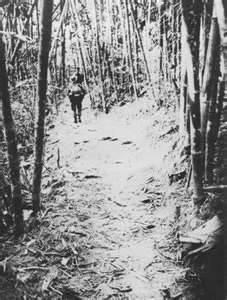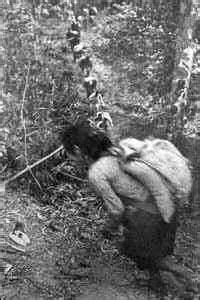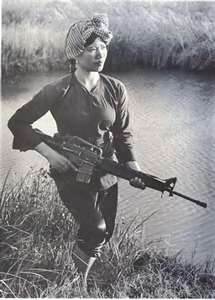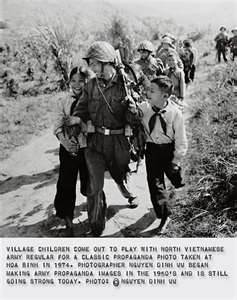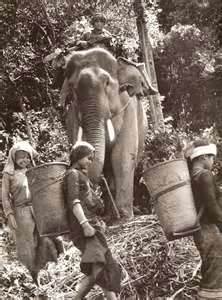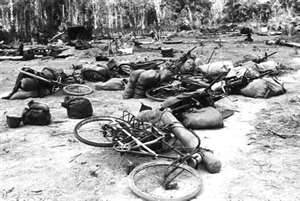
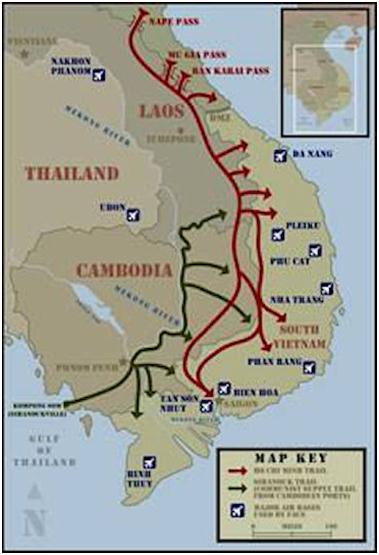
Ho Chi Minh Trail
A faceless enemy moving silently southward under the
jungle-covered mountains of eastern Laos, gliding slowly but
irresistibly like a giant snake. This deadly, well-camouflaged
snake was nearly invisible to Air Force eyes, but it struck
back viciously when it sensed danger. Worse yet, like a
mythical serpent cut into pieces again and again, it kept
bringing itself back together . . . steadily carrying its venom
southward towards the South Vietnamese and American
forces defending the Republic of Vietnam. The "snake" was
the North Vietnamese Army, the likes of which the United
States Air Force had never before encountered.
During World War II and the First Indochina War, the
Vietminh needed and developed effective "backwoods"
logistics systems. Included among these were routes which
connected the northern and southern parts of Vietnam.
With the beginning of the Second Indochina War, this trail
network was deliberately improved and operated to support
the aims of North Vietnam. Collectively, this system was
known as the Ho Chi Minh Trail.
In the Vietnamese language, its classified title was "Doan 559." The secret wasn't so much the identity of the
organization itself - the 559th Transportation Division, Rear Services Directorate, of Hanoi's Ministry of Defense - but
rather its mission. Simply maintaining and protecting an obscure road network in a remote region would hardly seem
to justify the extraordinary measures the Democratic Republic of Vietnam (DRV) expended to hide the 559th's
mission. Unless, of course, this obscure road network was the same highway about to become famous around the
world in its English translation nickname, "The Ho Chi Minh Trail." Another name given the trail is "The Blood Road".
Group 559 had the mission of creating a transportation network in Laos and was the operator of the Ho Chi Minh
Trail. This and subordinate organizations employed approximately 100,000 people at any given time during the war.
These personnel included engineers, porters, drivers, mechanics, laborers, ground security units, anti-aircraft units,
hospitals, and a complete assortment of other administrative and logistical support units.
The Ho Chi Minh Trail was not so much a single route but a network. In general it started with the transportation
arteries in North Vietnam, swung west into Laos, south parallel to the South Vietnamese border, and at various points
crossed back to the east and into South Vietnam. Some of the trails also went directly across the DMZ and into South
Vietnam. The Laotian part of the system continued further south into Cambodia and intersected with a network there
which was known as the Sihanouk Trail. The routes consisted mostly of small trails for personnel movement and roads
for vehicles. Personnel generally walked or pushed bikes along narrow foot-paths
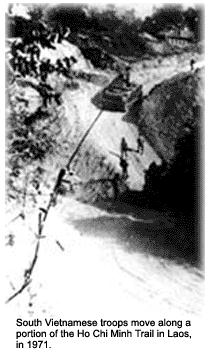
Excavated by hand, intricate interconnecting tunnels with concealed entrances
hid trail trekkers, often directly under the feet of American troops searching
for them. Radio and telecommunications facilities, food and weapons caches,
medical aid stations and barracks, all underground, hid thousands of the North
Vietnamese at any given time during the war. The trail system was vastly
improved. Even as more people used the trail, the trek was reduced to six
weeks for a fit soldier. President Lyndon Johnson responded in April 1965 by
directing an Air Force/Navy "maximum effort" against the Ho Chi Minh Trail.
Increased tactical air strikes were ordered, and for the first time the USAF's
giant, eight-engine B-52 strategic bombers joined the stick thrashing the Ho
Chi Minh Trail. Results: intelligence figures showed the 1965 NVA infiltration
numbers more than doubled over those of 1964. In addition to their legendary
endurance, members of the NVA had accomplished this feat through expert
use of camouflage, underwater bridges not visible to aerial view, and tactics
such as throwing gasoline-soaked rags along roads to seduce strike pilots into
believing they had struck meaningful targets.

The North Vietnamese also used the Ho Chi Minh Trail to send soldiers to the south. At times, as many as 20,000 soldiers
a month came from Hanoi by this way. In an attempt to stop this traffic, it was suggested that a barrier of barbed wire
and minefields, called the McNamara Line, should be built. The plan was abandoned in 1967 after repeated attacks by
the NLF on those involved in constructing the barrier.
The United States could not block the Ho Chi Minh Trail with ground forces, because the countries it passed through
were officially neutral. Extensive aerial bombing did not prevent the North Vietnamese from moving hundreds of tons of
war supplies per day down the Ho Chi Minh Trail to the south. The trail undeniably lay at the heart of the war. For the
Vietnamese of the North the Ho Chi Minh Trail symbolized the aspirations of a people - hiking it became the central
experience of a generation.
On November 11, 1968, Operation Commando Hunt was initiated by the U.S. and
its allies. The goal of the operation was to interdict men and supplies on the Ho
Chi Minh trail, through Laos into South Vietnam. By the end of the operation,
three million tons of bombs were dropped on Laos, which slowed but did not
consistently disrupt trail operations. The United States' aerial effort in the 1970s
to interdict the massive amounts of supplies rolling down the Ho Chi Minh Trail
from North Vietnam needed regular and reliable evidence of success or failure.
Did the mission succeed? That question needed a timely answer, daily.
Air Force and Navy reconnaissance aircraft routinely flew over the primary entry
points into Vietnam from southern Laos at Tchepone and the Mu Gia and Ban
Karai Passes. The road networks running north and south drew the camera's
attention at least once a week. The reconnaissance aircraft focused twice as often
on the transit points into Vietnam and Cambodia from Laos. In early daylight,
these flights sought to confirm the pilots' visual estimate of the damage inflicted
by night raids on North Vietnamese trucks running in near-dark conditions
through Laos, down the trail to logistics staging areas and to truck parks serving
as rest stops for continuing journeys. This reconnaissance effort sought to define
both mission effectiveness and possible targets for the next day's work.
Upon careful consideration, it seemed that the answer rested with the standard charts then in use by planners. In 1970,
detailed and accurate charts of Laos proved hard to find. Photo interpreters gradually discovered that the maps and
charts of Laos used for the Ho Chi Minh Trail interdiction missions, as well as other efforts, regularly demonstrated errors
of a few thousand meters. If the RF-4C reconnaissance and assessment teams had been flying to flawed coordinates to
monitor the effect of night missions accomplished just a few hours earlier that would explain a great deal.
To address this problem, the Air Force introduced the long-range navigation (loran) system into the equation. Loran
defines the location of any strike site by determining its distance from a known location via the elapsed time of a
dedicated radio signal between two or more points-providing much greater precision. The promise of using loran led the
Air Force and the Aeronautical Chart and Information Center (ACIC) in St. Louis, Mo., an NGA predecessor, to take this
possible solution a step further. The cartographers at ACIC took high-altitude photographs of Laos, Cambodia and
Vietnam and broke them into sections, 10 miles square. Loran-directed RF-4Cs photographed each block, and the
cartographers transferred the loran data to a series of photo maps, combining the high altitude work with the need to
have accurate maps and charts.
The loran control points on the photomaps then went into a growing database along with other significant mission
locations identified by the Air Force using those very same points. By 1971, the database became available for use at the
12th Reconnaissance Intelligence Technical Squadron at Tan Son Nhut airbase near Saigon. With accurate fixed points
both on the photomaps and retrievable from the computer, the reconnaissance squadron could within 45 minutes
accurately confirm the location of any strike point along the trail with a radio fix that related that location to the nearest
known loran control point.

Article copied from Global Security.org at https://www.globalsecurity.org/military/world/vietnam/ho-chi-minh-trail.htm
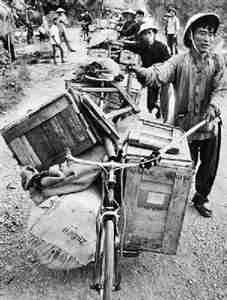
These personnel were both porters carrying war supplies and soldiers going south
to fight. This means was used throughout the war and constituted both a major
asset for the North Vietnamese and one which was extremely difficult to interdict.
The terrain also necessitated a vast amount of bridging to span the numerous
rivers, streams, and valleys. Once the roads were established, beginning in 1965,
heavy equipment and supplies were moved mostly by vehicle. Eventually, the
engineering effort would make many of the routes all-weather, thus evening out
the cyclic nature of infiltration. The individual NVA soldier slogged on foot down
the 600-mile-long Ho Chi Minh Trail for two to three months before exiting
somewhere in South Vietnam. But supplies were carried in vehicles. As early as
1965, an estimated 51 percent of these supplies went south in trucks on the
steadily growing road network. The percentages would grow. The low-tech NVA
was proving the worst of all possible targets for a high-tech air force better suited
for an opponent in its own league. To incredulous intelligence officers, the snake
actually seemed to be growing stronger on the diet of American bombs.Thousands
of laborers worked around the clock to expand the Ho Chi Minh Trail and repair
damage caused by US air strikes. Some were North Vietnamese volunteers, many
of whom were young women given room and board, clothing, and the equivalent
of $1.50 per month; others were prisoners and local Laotians who had been
conscripted.
At least 10 percent of the casualties along the trail were from such illnesses as malaria. At regular intervals along the
route, the National Liberation Front(NLF) built base camps. As well as providing a place for them to rest, thebase
camps provided medical treatment for those who had been injured or had fallen ill on the journey. Most of the base
camps were underground..

In spite of these assets, in 1970 the needed assessments
did not come easily. In one case, the crew of an RF-4C
reconnaissance aircraft flying early morning missions
during the 1969-1970 dry season could confirm only seven
of 103 trucks reported destroyed during the first six weeks
after the intense rain ceased. Given the proven
effectiveness of the AC-130 gunships and repeated pilot
reports of success, the inability to verify the damage
inflicted became a critical problem. Did the missions fail?
Were the pilots mistaken? Did the North Vietnamese road
crews clear the debris away and repair the bomb craters
quickly enough to cover up any sign of the attack?
With this available combination of talent and technology,
the photo interpreters began working with forward air
controllers to address the immediate needs of any mission
in progress with the new loran-driven tools. The controllers
would have the photomaps in hand, with a special grid
superimposed. They provided the location of a target or a
successful strike as portrayed on their photomap to the
technical squadron at Tan Son Nhut, along with the
information supplied by the grid. The technical squadron
could then supply the pilot with his loran position, both for
his purpose and to revisit the point of attack later for
evaluation and lessons learned.
Following the January 1973 Paris cease-fire agreement, PAVN had greatly expanded its logistics lifeline to the South,
the Ho Chi Minh Trail. With the trail complex no longer subject to US air attacks, North Vietnam was shipping massive
quantities of supplies and equipment southward--80,000 tons of military supplies in 1973 alone, including 27,000 tons
of weapons, 6,000 tons of petroleum products, and 40,000 tons of rice. One hundred thousand fresh PAVN troops had
marched down the trail to the South during 1973, and another 80,000 were on their way south during the first half of
1974. PAVN's troop strength in the South, decimated by the 1972 Easter offensive, now stood at its highest level of the
war--400,000 full-time soldiers.
By 1975,the NVA had matured into a modern mechanized force; to exploit this new capability, they upgraded the Ho
Chi Minh Trail into a two-lane highway, paralleled by a pipeline with pumping stations for supplying fuel. This "trail"
was supplemented by a network of east-west feeder roads, particularly in the I Corps area, that allowed the North
Vietnamese to launch their attacks eastward with great rapidity from sanctuary positions close to the South
Vietnamese positions. By attacking on a basically west-to-east axis, the NVA prevented the ARVN divisions in I and II
Corps from concentrating their forces as they could have done if the NVA had been forced to launch their assault
across the DMZ along a generally north-to-south axis.
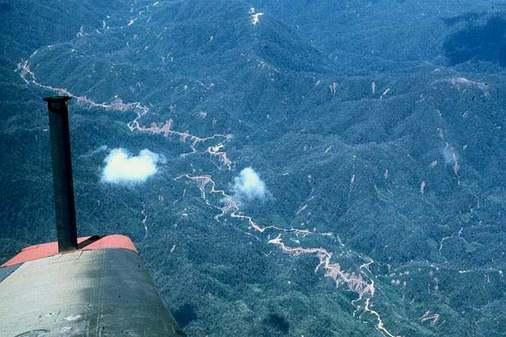
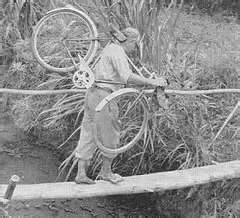
Lead in to article -
For the 25th Division and our unit, the effects of the "Trail" were felt in our operations northeast of Dau Tieng through War Zone C down through and east of the Michelin Rubber Plantation. Later, when we moved down into the Hobo Woods area, again we were facing the infiltration of the trail as it passed through the Boi Loi Woods, Iron Triangle and crossed over the Saigon River through the Mushroom, south through Sa Nho, Trung Lap, skirting the Filhol Rubber Plantation, Hoc Mon and Duc Hoa and into Saigon City. If the soldier was not on foot, boats were used to navigate via rivers and canals as the North moved material and men into the Capital area.- Sarge AK
For the 25th Division and our unit, the effects of the "Trail" were felt in our operations northeast of Dau Tieng through War Zone C down through and east of the Michelin Rubber Plantation. Later, when we moved down into the Hobo Woods area, again we were facing the infiltration of the trail as it passed through the Boi Loi Woods, Iron Triangle and crossed over the Saigon River through the Mushroom, south through Sa Nho, Trung Lap, skirting the Filhol Rubber Plantation, Hoc Mon and Duc Hoa and into Saigon City. If the soldier was not on foot, boats were used to navigate via rivers and canals as the North moved material and men into the Capital area.- Sarge AK
Slide Show of the Trail




